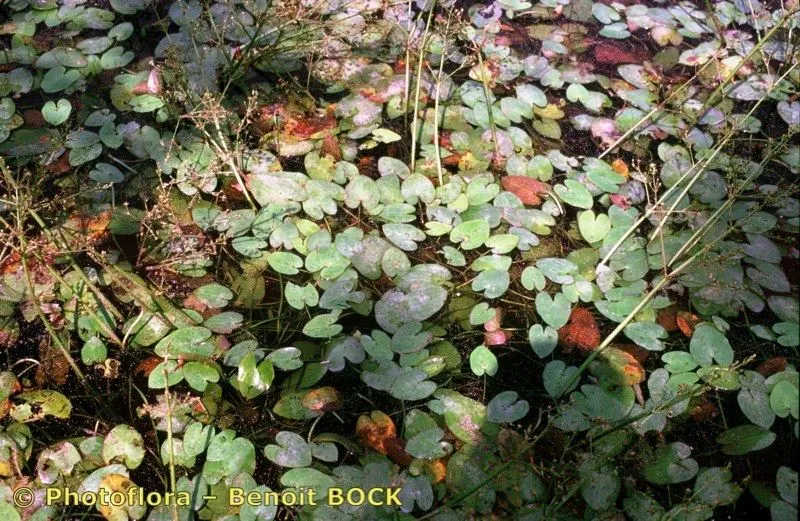
Author: (Bassi) Parl.
Bibliography: Fl. Ital. 3: 599 (1860)
Year: 1860
Status: accepted
Rank: species
Genus: Caldesia
Vegetable: False
Observations: Europe, Africa, Caucasus, Russian Far East to Trop. Asia and Queensland
The Parnassus-leaved water plantain, scientifically known as Caldesia parnassifolia, is an intriguing member of the Alismataceae family. First documented in detail in Flora Italica (Fl. Ital. 3: 599) in 1860 by Parl. and originally classified by Bassi, this aquatic plant has garnered attention for its unique characteristics and widespread distribution.
Caldesia parnassifolia thrives in a variety of regions across multiple continents, showcasing a remarkable adaptability. It can be found throughout Europe and Africa, extending its presence into the Caucasus region and the Russian Far East. Its range continues into tropical Asia and even reaches as far as Queensland, Australia. This extensive geographical distribution speaks to the plant’s resilience and ability to prosper in diverse climatic conditions.
A visual delight, the Parnassus-leaved water plantain typically inhabits wetland areas such as ponds, lakes, and slow-moving bodies of water. Its leaves, reminiscent of the Parnassus plant, lend the species its common name. These leaves often form a rosette pattern, floating gracefully on the water’s surface and creating a serene aquatic landscape.
This perennial plant produces delicate white to pale pink flowers that stand above the water on slender stems. The blossoms add an element of gentle beauty to their environment, attracting a variety of pollinators and contributing to the ecological health of their habitats.
Despite its widespread occurrence, Caldesia parnassifolia is experiencing pressures from habitat destruction and environmental changes in some regions. As such, conservation efforts have become increasingly important to ensure that this species continues to thrive and maintain its role in the biodiversity of wetland ecosystems.
In summary, the Parnassus-leaved water plantain (Caldesia parnassifolia) is a remarkable aquatic plant notable for its widespread geographical range and delicate beauty. Its presence in various regions underscores its adaptability and ecological significance, further emphasizing the need for ongoing conservation efforts to protect this species and its natural habitats.
Deu: herzlöffel
Pol: kaldezja dziewieciornikowata
En: Parnassus-leaved Water Plantain, Parnassus-leaved Water-plantain
Be: Кальдэзія відомцалістая
Bg: Парнасиеволистна калдезия
Zh: 泽苔草
Cs: Vzplývavka tolijolistá
Fr: Alisma à feuilles de parnassie, Caldésie à feuilles de parnassie, Flûteau à feuilles de parnassie
De: Herzblättrige Caldesie, Herzblättriger Froschlöffel, Herzlöffel, Caldesie
Hu: Lápiszíveslevelű-hídőr
It: Mestolaccia minore
Lt: Širdžialapė kaldezija
Fa: کالدسیا پارناسیفولیا
Pl: Kaldezja dziewięciornikowata, Kaldezja dziewieciornikowata
Ru: Кальдезия белозоролистная
Zh-hant: 澤苔草
Uk: Кальдезія білозоролиста
: Parnassus-leaved water plantain
Taken Jul 15, 2012 by Photoflora – Jean-Luc TASSET (©)
Taken Jul 15, 2012 by Photoflora – Jean-Luc TASSET (©)
Taken Jul 15, 2012 by Photoflora – Jean-Luc TASSET (©)
Taken Jul 15, 2012 by Photoflora – Jean-Luc TASSET (©)
Taken Nov 17, 2022 by Blue Bottle (cc-by-sa)
Taken Aug 15, 2000 by Photoflora – Benoit BOCK (©)
Taken Nov 17, 2022 by Blue Bottle (cc-by-sa)
Taken Aug 15, 2000 by Photoflora – Benoit BOCK (©)
Taken Sep 15, 2006 by Photoflora – Benoit BOCK (©)
Taken Sep 15, 2006 by Photoflora – Benoit BOCK (©)
Taken Sep 15, 2006 by Photoflora – Benoit BOCK (©)
Taken Jan 1, 1970 by Photoflora – L’Abbé COSTE (©)
Taken Aug 15, 2000 by Photoflora – Benoit BOCK (©)
Taken Aug 15, 2000 by Photoflora – Benoit BOCK (©)
Taken Aug 15, 2000 by Photoflora – Benoit BOCK (©)
Taken Aug 15, 2000 by Photoflora – Benoit BOCK (©)
Taken Aug 15, 2000 by Photoflora – Benoit BOCK (©)
Taken Sep 15, 2006 by Photoflora – Benoit BOCK (©)
Taken Sep 15, 2006 by Photoflora – Benoit BOCK (©)
© copyright of the Board of Trustees of the Royal Botanic Gardens, Kew.
© copyright of the Board of Trustees of the Royal Botanic Gardens, Kew.
© copyright of the Board of Trustees of the Royal Botanic Gardens, Kew.
Ph maximum: 7.0
Ph minimum: 6.5
Light: 7
Atmospheric humidity: 8
Bloom months: [‘aug’, ‘sep’]
Soil nutriments: 5
Family: Myrtaceae Author: (F.Muell.) K.D.Hill & L.A.S.Johnson Bibliography: Telopea 6: 402 (1995) Year: 1995 Status:…
Family: Rubiaceae Author: Pierre ex A.Froehner Bibliography: Notizbl. Bot. Gart. Berlin-Dahlem 1: 237 (1897) Year:…
Family: Sapindaceae Author: Koidz. Bibliography: J. Coll. Sci. Imp. Univ. Tokyo 32(1): 38 (1911) Year:…
Family: Asteraceae Author: A.Gray Bibliography: Pacif. Railr. Rep.: 107 (1857) Year: 1857 Status: accepted Rank:…
Family: Fabaceae Author: Medik. Bibliography: Vorles. Churpfälz. Phys.-Ökon. Ges. 2: 398 (1787) Year: 1787 Status:…
Family: Aspleniaceae Author: (Cav.) Alston Bibliography: Bull. Misc. Inform. Kew 1932: 309 (1932) Year: 1932…